The Gatling Gun is interested for many reasons, and one of them is the variety of feeding mechanisms that were developed and used with it. Most firearms are designed around a single specific feeding mechanism, sometimes with variants made for two types (like mag-fed and strip-fed Hotchkiss LMGs). The Gatling was one of the very first high rate of fire guns, though, and it inspired an impressive number of inventors to develop feed systems. Let’s take a look at them all, shall we?
Hopper
The first Gatling guns used a very simple hopper to feed ammunition. It was cast into the action cover, and could be continuously topped off by the assistant gunner while the gunner aimed and fired the gun. It was simply gravity fed. To assist in loading, cartridges could be fed into the hopper from very simple purpose-made tin boxes, which held 40 rounds each. These boxes were not magazines in the modern sense, as they had no springs or followers, and were used simply to pour cartridges into the gun’s hopper.
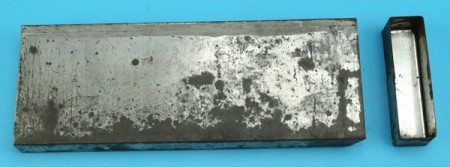
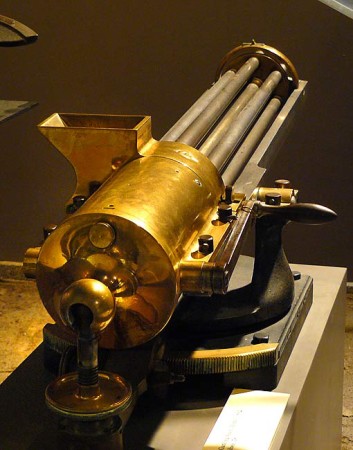
Box Magazine
With the introduction of the 1871 Gatling, the tin cartridge boxes were replaced by a true early box magazine. Instead of being manually dumped into the hopper, the new magazine would fit and lock into the feed hopper, and included a flat spring on the side which prevented cartridges from falling out of the magazine unless it was secured in the gun, at which point the spring was lifted up and out of the way (similar to a Madsen or Johnson LMG magazine).

Gatling mags of this period vary in capacity and curvature, depending on the cartridge they were designed for. These magazines also included weighted followers to help push rounds into the gun, although these were not spring loaded. Feed boxes for the 1865 model had been made with followers, but still having removable lids instead of spring catches to hold in ammunition. Early guns held the magazines at a 45 degree angle off the left side of the gun:
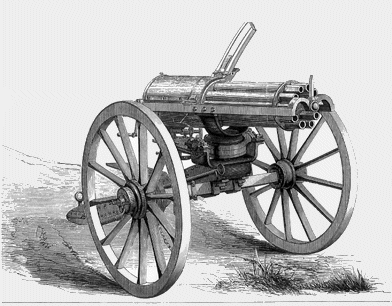
The angled magazine was located so as to allow use of the sights, which were located centrally on the gun. In 1874 this arrangement was changed, though, and the sights were moved to the right side to allow a vertical magazine on the centerline of the gun. This reduced friction in the mag, and improved feeding.
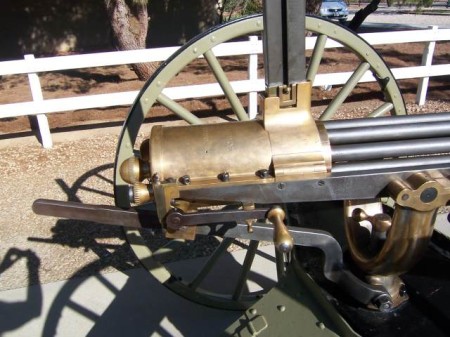
Broadwell Drum
In 1872, a new type of feed device was patented by the Gatling company, named after L.M Broadwell (the employee who devised it). According to the patent, this drum consisted of twenty stacks of cartridges arrayed in a circle with the bullets pointing inwards at a central column (kind of like a Lewis or DP drum). Each stack held twenty rounds, giving the drum a total capacity of 400 rounds. At the bottom of the drum was a metal plate with a hole to allow cartridges from one stack to drop down into the gun. In actual use, drums were typically a bit smaller, with the standard being sixteen stacks of fifteen rounds each (for a total of 240 rounds).
To load it, one would set the drum upside down, and drop 15 rounds into each column, rotating the bottom plate to access them. Then the plate would be rotated to a position in between two stacks so that no cartridges could fall out, and be mounted onto the gun. The body of the drum then had to be manually indexed to line a stack of cartridges up with the hole in the bottom plate, and then rotated to the next stack when all 20 rounds were fired. It’s a bit tricky to explain, so here is a brief video on it:
As best we can tell, Broadwell drums were used primarily in Naval applications, where the unit’s weight (about 50 pounds loaded) was not particularly problematic. However, it had some definite limitations. The drum was held on the gun only by gravity, and could simply fall off if fired at too steep an elevation or depression. Additionally, feeding became less reliable at steeper angles, as gravity alone also was responsible for dropping cartridges into the gun.
Bruce Feed
The most popular feed mechanism for the Gatling in US Army service was the Bruce Feed, which you can see in use on our recent video of a reproduction 1877 Gatling. It was a feed mechanism which was easily loaded from standard 20-round ammunition boxes, and easily allowed continuous fire. The reason for this is that the Bruce device could be topped up with 20 rounds or so of ammo already in it, thus giving the loader plenty of time. Gatlings could not maintain fire while changing box magazines.
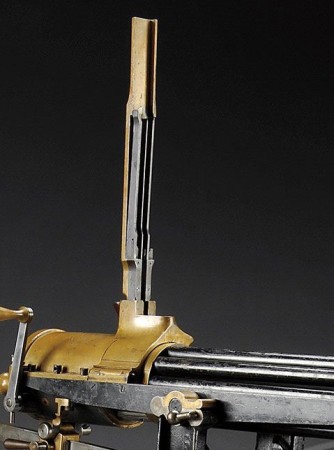
Early Bruce feed mechanisms were made to fit guns originally designed for box magazines, but later productions guns were made specifically for the device, as it because the standard order for the US military. It would remain the preferred feed mechanism right up to the end of the military use of the gun, including the models in .30-40 and .30-06 calibers.
Accles Drum
The Accles drum was the most complex feed system designed for the Gatling, and in theory offered the most advantages as well. It was a large donut-shaped device which held 104 rounds in a long spiral groove (much like a Chinese AK drum). A rotor inside the drum (also like the AK drum) held the cartridges in position, and as the gun was cranked the action cylinder would interact with the Accles drum rotor forcing it to turn. As the rotor turned, it would drive the cartridges around the spiral groove inside the drum body, which ended at the entrance to the gun. Thus, cartridges were positively pushed into the gun exactly as fast as it was being fired, regardless of speed or angle of elevation. You can see the full Accles feed patent here.
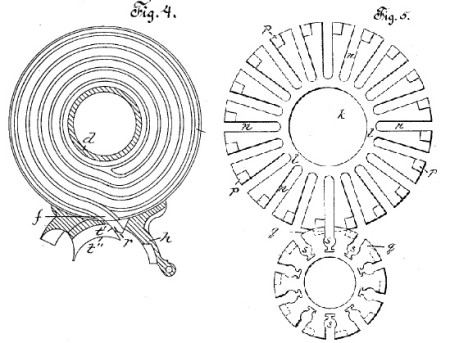
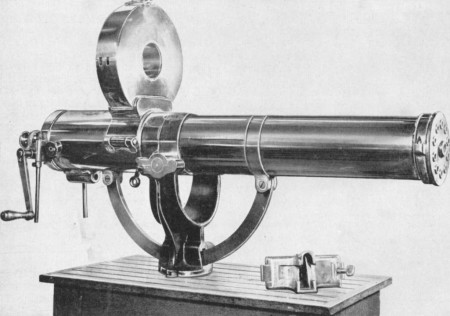
Unfortunately, while the Accles feed was very effective when clean, it was too fragile for the rigors of field use. It did not take much dirt to impede the rotor from turning, and a dent in the thin walls of the drum could disable it completely. The US military dropped them from use, and converted their 1883 models back to using the Bruce feed system.
However, the Accles drum was the best feed system for use at very high speeds, and it was used in experiments with electrically-powered Gatling guns both in the late 1800s and much later during development of the Vulcan cannon.
Feed Strips
The Model 1893 Gatling was introduced in the new military .30 US (aka .30-40 Krag) cartridge, and came with a feed strip system very similar to the Hotchkiss machine gun. The Army bought 18 of these guns, with the option to have them converted to Bruce Feed if the strip system was not satisfactory.
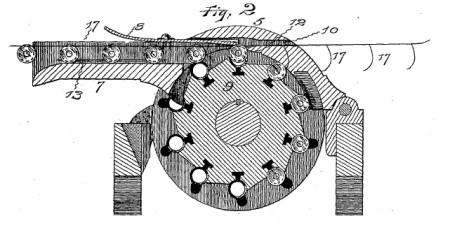
The benefit of the strip feed is that is was mechanically actuated by the gun (“Positive Feed” according to the Gatling company), because the rotating cylinder of the gun pulled in the cartridges. This allowed the gun to reliably feed at any speed and any angle of elevation, where gravity-based systems could become unreliable. The feed strips were possible to reload, but intended to be disposable.
Ultimately the feed strip system was unable to impress the Army, and in 1897 all 18 guns built with it were converted to the tried-and-true Bruce feed. You can see more diagrams of the system in the original Gatling feed strip system patent.
Stripper Clips
We don’t know much about this particular adaptation of the Gatling, but it is clearly designed to feed from 5-round infantry rifle chargers. We found it at the Paris Musee de Armee – perhaps someone can tell us more about it?
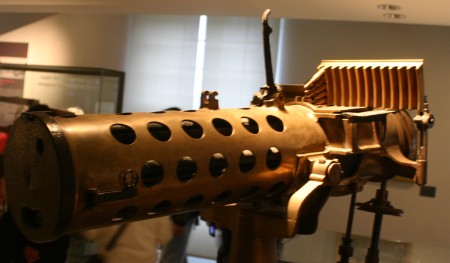


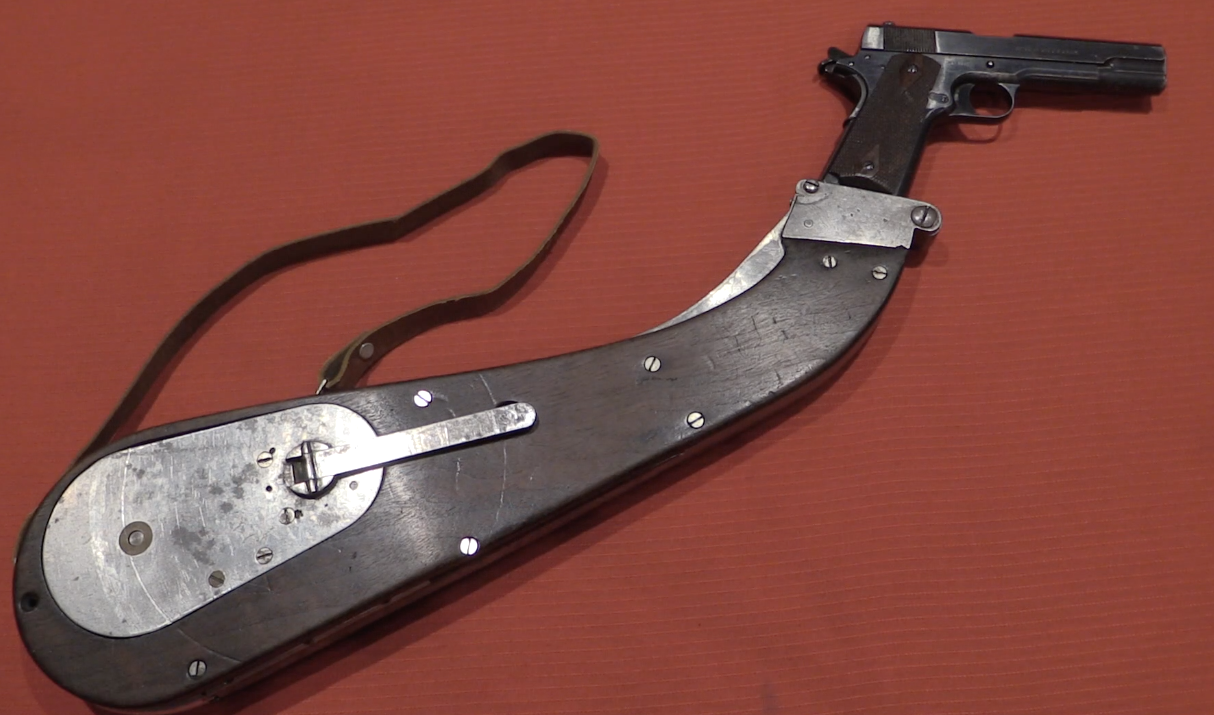
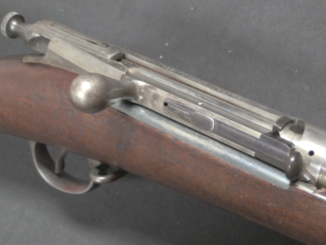
I hate to be first to pop into it…. but this is a spectacular review! Just one question would come to mind when feeding rimmed roung such as .45-70 is a chance that rounds would snag… but they did not seem to at displayed Bruce feed. One may be of impression therefore, that rounds actually ‘stand’ and each other’s rim.
They don’t snag, because the groove for the rims is only deep enough for a single rim to fit in. Rimlock is a problem in magazine-fed rifles because one round will move forward and have its rim resting atop the next cartridge. The groove in the Brice feed device doesn’t give the rounds room to move forward, so rimlock doesn’t happen.
Rimlock doesn’t happen with the Brucefeed because the groove is terminated above the rotating feed block to allow the round to fall free as the left to right turning barrel carrier draws the round sideways. the rim groove is actually a fairly loose tolerance.
If I remember correctly, the version of the Gatling fitted with the Broadwell drum was intended for use not only on deck mountings, but also high up in the fighting tops of vessels of the period, where they could command a clear field of fire across the decks of a nearby enemy vessel, or even one’s own decks if boarded. The latter application might have been a bit problematic, given the non-positive drum engagement and steep angles of depression required.
Most early naval Gatlings appear to have been chambered in 0.65″, whereas the Army preferred the lighter 0.45″ or 0.50″ versions which were easier to manhandle.
I had no idea of the different type of feed systems that evolved for the weapon,very interesting and informative. Thanks
If anyone is interested, there is a very good, concise historical summary of the early multi-barrel mechanical guns ranging from the Billinghurst Requa Battery Gun and Ager “Coffee Mill” through the Claxton, Williams and Vandenberg Volley guns to the Confederate Revolving Cannon, Gorgas Machine Gun, Gatling and Hotchkiss Revolving Cannon, to name a few. It can be found on-line under the title “Hyperwar: The Machine Gun (Vol I/Part II)”. The cached page is entitled “The Machine Gun Part II – Manually Operated Machine Guns” and the link is http://www.ibiblio.org/hyperwar/USN/ref/MG/l/MG-2.html.
You perhaps meant the Chinn ‘Machine Guns’ Vol.1?
It might have been an excerpt from Chinn, but I’m not absolutely sure as I didn’t have enough time to follow up ( it was just a random page I happened to spot on the Web while following a link ).
Out of curiousity, I keyed in “French Gatling Gun” on the Bing.com search engine and found a page with a long series of photographs under the post “Images of French Gatling Gun”. The strip-fed French Gatling shown above shows up in a few scattered pictures, including the very first one. Clicking on that image took me to what was obviously the on-line posting for the author’s (MathTeacherGuy’s) 2007 vacation in France, including a visit to the French Military Museum in Les Invalides in Paris. He even includes a street map showing the location of the Museum near the famous Ecole Militaire. In the photostream on the right side of the page, additional images of the same gun can be pulled up. What’s really intriguing are additional photos he took of an unusual 3-barreled pistol and a bronze or brass mortar, both also on display in the same Museum.
Going back to the top of the “Images of French Gatling Guns” page, there is a header called “Gatling Gun Blueprints” ; clicking on that will take the reader to another photo page filled with images of Gatlings and other mechanical guns, as well as several very interesting blueprints.
This is a 1895 APX Gatling in 8 mm Lebel, fed from a sliding round holder for 12 stacks of 5 rounds, 60 rds in total. The cartridges are fed into the grooves of the sliding block, loose, and a feed arm is placed on top of the stack. With cranking the handle, the feed arm (set vertically in this photo in front of the magazine) pushes the rounds down, into the receiver hopper, and indexes itself after the slide moves one stack to the side for each five shots – pretty much like the FIAT-Revelli, but hand-operated and without springs. At the same stand at the Invalides there is also a 1893 model of the same gun, mounted on a tripod.
Leszek, thank you so much for taking the time to fully identify the French Gatling in question, and for the additional technical information. This also helps to answer Ian’s last-paragraph query in this post about the gun.
There was a version of the BROADWELL Magazine which had two separate retaining devices opn to hold the magazine to tthe gun and one that allower positive indexing of the different vertical stacks. I will be forwarding top you a photo of the mechanism as it was a simple solution and is found on a few of the GATLING GUNS at the ARSENAL Museum in Copenhagen Denmark.
Check out this YouTube Channel: http://www.youtube.com/user/vbbsmyt/videos?view=0&flow=list&sort=dd There are all kinds of early machine guns rendered in 3-D animations showing how the mechanisms work. There are Gatlings as well as Gardners and Nordenfelts among others.
Very well explained!
definitely informative!but how about the mechanism for extracting cartridges,i’m still having a problem understanding that.
I was doing research for a western novel I am writing and your information was wonderful.
Glad I could help!
What about the proposed use of canvas belts like used on the Maxim mg, or the linked belt, or the more modern evaporating linked belt liked on the dilon or valcon guns?
18 model 1893 Gatlings were made and tested with a brass 45-70 feed strip, they did not work out well and were converted to the 1895 model in 30-40 caliber with the then standard Bruce Feeds.
I’d love to make this in .22 short. Any ideas?
Looking at that Accels drum/magazine on the Gatling, I seemed to recall a US Army 37mm Auto-cannon (Mk 4, Mk 9 or possibly Mk 10) that had a similar looking magazine. Was there any relationship to the Accels? And If you know the answer, When was the first documented testing of electrically driven or steam driven Gatlings done?
If you like Westerns with Gatling guns in the story that you will certainly find interesting read REDEMPTION AT PURGATORY available everywhere e-books are sold. Soon to be in print edition. I love this article above and wish I had thuoght to access all this information when I was doing research for my book. I pretty much used military models and models that were supposedly never produced. I love some of the comments posted here. Please buy my book and you can make comments to the Amazon’s and the Barnes & Nobles for a wider readership. Hope everyone of you enjoys a prosperous, healthy 2016 filled with joy and progress.
I’m searching information about the Gatling fully Automatic machine shotgun. I’ve seen two of them in the Norwegian Navy Museum in Horten Naval Base in Norway in 1980. This weapon was totally banned around 1923 because of the horrible injuries it resulted in giving, as it could shoot up to 400 shots per minute, and every shot had 18 lead-bullets in pairs With thin piano-strings measuring from 5 cm. up to 15 cm. and thus inflicting very cruel injuries
Does anybody have any measurements or high definition pictures of the 1862? I’m looking for any information I can use in accurately reproducing it.
Talking about Gatling Gun feed systems reminded me of something kind of odd. In the movie “Two Mules For Sister Sarah”, Clint Eastwood taps the magazine of a Gatling Gun as he fires it. I always thought he was doing that to help “settle” the rounds.
As for the rims jamming, I believe that the box feed was made slightly triangular so that the bullets were atop each other, but the rimmed bases of the cartridges were slightly positioned left and right, also avoiding the magazine curve as with the Bren Gun and the Type 99.